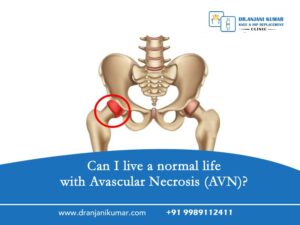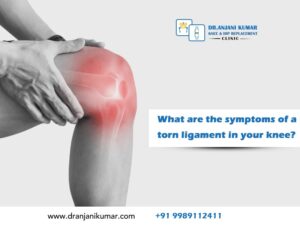Hip arthroplasty, or hip replacement surgery, is commonly recommended for patients with severe osteoarthritis, a degenerative joint disease causing pain, stiffness, and reduced mobility. This surgery is often recommended for patients who do not respond well to conservative treatments like medication, physical therapy, or lifestyle modifications. Other indications include rheumatoid arthritis, avascular necrosis, hip fractures, and certain congenital or developmental hip disorders.
Hip replacements can be done for several reasons, including:
- Osteoarthritis:
- This condition causes most hip arthroplasty cases.
- Osteoarthritis is a degenerative joint disease characterized by the breakdown of cartilage in the hip joint, leading to pain, stiffness, and reduced mobility.
- Rheumatoid arthritis:
- It is associated with joint damage, pain, and loss of function due to inflammation of the synovium (lining of the joint).
- Avascular necrosis:
- A condition in which the blood supply to the hip joint is compromised, resulting in the death of bone tissue and eventual collapse of the hip joint.
- Hip fractures:
- Severe fractures of the hip joint, particularly in older adults, may require hip arthroplasty for stability and to restore function.
- Congenital or developmental hip disorders:
- Certain conditions present at birth or developed during childhood, such as developmental dysplasia of the hip (DDH) or Perthes disease, can lead to abnormalities in hip joint structure, requiring surgical intervention.
- Post-traumatic arthritis:
- Traumatic injuries to the hip joint, such as fractures or dislocations, can lead to post-traumatic arthritis, necessitating hip replacement if conservative treatments are ineffective.
- Tumours or bone loss:
- Hip replacement may be necessary in cases of bone tumours or significant bone loss due to trauma or other conditions or the removal of the damaged joint and its replacement with an artificial hip joint.
- Other causes of hip pain:
- Hip arthroplasty may also be considered for other causes of chronic hip pain and disability that do not respond to conservative treatments, such as severe hip bursitis or certain hip joint infections.
- Failed previous hip surgeries:
- Revision hip replacement may be necessary if a previous hip surgery, such as hip arthroplasty, has failed or if there are complications.
Hip arthroplasty is a procedure that replaces damaged or worn-out parts of the hip joint with artificial components to improve function and reduce pain. It is recommended after conservative treatments have proven ineffective and the individual’s quality of life is significantly compromised due to hip joint issues, as determined by a healthcare provider’s evaluation of symptoms, functional limitations, and overall health status.
What is hip arthroplasty?
Hip arthroplasty is a surgical procedure that replaces a damaged or diseased hip joint with a prosthesis, aiming to relieve pain, improve joint function, and enhance mobility and quality of life. The hip joint, a ball-and-socket joint, can deteriorate due to conditions like osteoarthritis, rheumatoid arthritis, osteonecrosis, hip fractures, or other degenerative disorders, causing pain and limiting movement.
The following stages are commonly involved in a hip arthroplasty procedure:
- Femoral component:
- This part replaces the head of the femur.
- It consists of a metal stem that is inserted into the hollow centre of the femur and a ball that replaces the damaged femoral head.
- Acetabular component:
- This part replaces the head of the femur.
- It consists of a metal stem that is inserted into the hollow centre of the femur and a ball that replaces the damaged femoral head.
- Preparation of the bone:
- The damaged cartilage and bone from the femoral head and acetabulum are removed to create a suitable surface for the placement of the artificial components.
- Implantation of the prosthesis:
- After that, the prosthetic hip joint components are placed.
- The prosthetic components consist of a metal or ceramic ball that replaces the femoral head and a metal or plastic socket that is inserted into the acetabulum.
- These components may be cemented or press-fit into the bone, depending on the patient’s condition and the surgeon’s preference.
- Closure:
- Sutures are used to seal the incision and heal the wound.
Hip prostheses come in various types, with metal-on-plastic, ceramic-on-plastic, or metal-on-metal articulations. The choice depends on the patient’s age, activity level, and surgeon’s recommendation. Post-prosthesis, rehabilitation and physical therapy help patients regain strength, flexibility, and function. Most patients experience pain relief and improved mobility, allowing them to resume daily activities with reduced discomfort.
Standard precautions often advised after hip arthroplasty include:
- Weight-bearing restrictions:
- Patients are often given weight-bearing restrictions, especially in the initial postoperative period.
- Using crutches, walkers, or other assistive devices may be required.
- The goal is to protect the newly replaced joint and allow proper healing.
- In the initial postoperative period, patients may be instructed on weight-bearing limitations.
- The surgeon will determine the specific restrictions based on the patient’s condition and the surgical approach.
- Movement restrictions:
- During the early stage of recovery, specific movements, such as crossing the legs, bending the hip beyond a certain angle, or twisting the hip excessively, may be restricted.
- These restrictions help protect the healing tissues and prevent dislocation of the artificial joint.
- Avoid high-impact activities:
- Patients are generally advised to avoid high-impact activities, such as running or jumping, which can place excessive stress on the hip joint.
- Low-impact activities like walking and swimming may be recommended for cardiovascular exercise.
- Physical therapy and exercises:
- Engaging in a prescribed rehabilitation program is crucial for restoring strength, flexibility, and range of motion.
- Physical therapy exercises help improve muscle function, joint stability, and overall mobility.
- Patients should adhere to the recommended exercise regimen as directed by their healthcare providers.
- Follow-up appointments:
- Regular follow-up appointments with the orthopaedic surgeon are essential for monitoring the recovery progress, addressing concerns, and adjusting the rehabilitation plan.
- Medication management:
- Patients may be prescribed pain medications and blood thinners to manage pain and reduce the risk of blood clots, respectively.
- It’s essential to take medications as prescribed and report any adverse reactions or concerns to the healthcare team.
- Dental precautions:
- Some surgeons recommend antibiotic prophylaxis before dental procedures to reduce the risk of bacterial infection reaching the artificial joint.
- This precaution is usually advised for a certain period following surgery.
- Preventing falls:
- Fall prevention is crucial during the recovery period.
- Patients are advised to remove tripping hazards from their living environment, use assistive devices as recommended, and practice cautious movements to avoid falls.
- Activity modifications:
- Patients may need to modify their activities to avoid high-impact or strenuous movements.
- Low-impact exercises such as walking and swimming are often encouraged.
- Healthy lifestyle:
- Adopting a healthy lifestyle, including a balanced diet and maintaining a healthy weight, can contribute to overall well-being and support the healing process.
Patients should communicate openly with their healthcare team and follow postoperative instructions, as each recovery plan may be tailored to their needs. Consult with the surgeon or healthcare provider for personalized advice.
About Dr Anjani Kumar
As an orthopaedic surgeon in Hyderabad, I try to provide patients with as many options as possible for hip and knee treatments to help each patient have the greatest results. I carefully consider the specific sorts of injuries and need to be comfortable offering a specialised solution before recommending the best course of therapy for each patient. My patients’ enhanced mobility and pain reduction are always my top priorities, as these will enable them to resume an active lifestyle. In more severe cases, especially when the joint has collapsed, or the bone has suffered extensive deformation, knee replacement surgery may be advised.
Knee replacement surgery may be recommended in advanced cases, especially if the joint has collapsed or the bone has become severely deformed.
Dr Anjani Kumar has 20 years of experience and successfully performed 2000 knee replacement surgeries, 350 hip replacement surgeries, and 500 pelvic acetabular surgeries throughout his career. Please get in touch with us on Mobile: at +91 9989112411 and by E-mail: anjanikumar@ gmail.com




